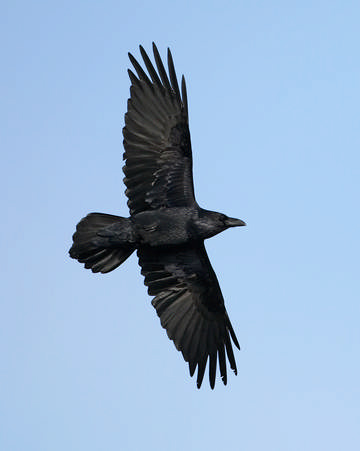
Raven © Richard Steel
Breeding Ravens rarely wander far in winter, and indeed many of them start nesting activities within our defined ‘winter’ period. Non-breeding birds, however, may roam much more widely and the species was reported in winter in almost one quarter of the county; in addition to the mapped records, there were 77 tetrads for which Ravens were recorded in winter ‘in flight’ only. There are probably now few parts of the county over which Ravens have not flown, and their distinctive bulky shape with a wedge-tail is becoming more familiar to Cheshire and Wirral people. They most often draw observers’ attention by their deep ‘cronk’ call, or their mobbing by other corvids. Roughly speaking, small birds flap and large birds soar, and the wing-loading of Raven is such that it is at the boundary between these two modes of flight, choosing to soar as long as there is sufficient uplift from rising air. They can effortlessly cover a large area, scanning the ground below for suitable food, especially carrion from large mammals. They will, however, eat almost anything including earthworms and beetles and some seeds, with estuarine birds taking fish and seaweed (Ratcliffe 1997). Some birds are very wary; others can become almost tame. Two lucky Atlas workers had a bird feeding on their lawn, and sometimes Ravens scavenge on landfill sites.
They obviously used to be extremely scarce in the county. Coward and Oldham have no records, at any season, after the mid-19th century. Bell recorded only one in the first half of the 20th century, a bird judged to be an ‘escape’ in 1931, then single winter birds in January 1958 and January 1959, with two over Hilbre in February 1962. Birds mentioned in the 1969 and 1971 county bird reports were adjudged to be escaped pets, and the first to be taken seriously were several birds in 1975 and 1976, at various Dee estuary sites and in the east of the county. From 1980 onwards they have been recorded annually in increasing numbers. The 2005 Cheshire and Wirral Bird Report states that ‘records from the eastern area predominant as usual’ but this Atlas map shows that birds are widespread across the county, with the highest densities of occupied tetrads in the agricultural southwest of Cheshire. Presumably the bird report comment says more about the geographical distribution of regular contributors of records than of the Ravens themselves. Most of the county’s birds are using farmland in winter: of the 177 habitat codes submitted, 97 (55%) were of farmland, with 51 woodland, 12 human sites and 9 saltmarsh.
Most winter Atlas counts were of one or two birds, but there were two flocks of six birds, whilst eight were at Bosley Cloud on 3 January 2005 and Richard Smith also saw eight in 2006/ 07 near Heswall (SJ28L). These appear to be the largest flocks on record in the county. Some winter gatherings in other counties are large, even reaching hundreds of birds, and similarly large communal roosts have been reported, but not, yet, in Cheshire and Wirral. There must be at least 200 Ravens in winter in the county, made up of 50 breeders, 50 first-winter birds, 100 immature (1-3 year-olds) and some wandering birds from elsewhere.
Sponsored by Christian and Sue Heintzen

